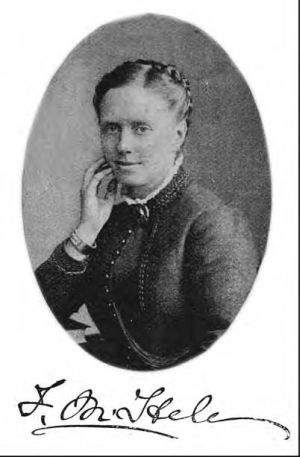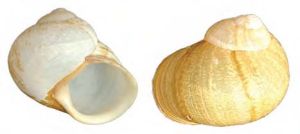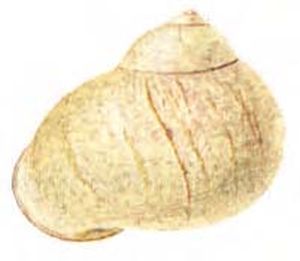|
Perhaps nowhere in Britain are snails more abundant than they are in and around Bristol. This is especially true of the Common Garden Snail, Cornu aspersum. At least that is how it used to be during the second half of the nineteenth century, when Miss Fanny M. Hele was active there. Her name may have meant nothing to anyone today had she not become an avid collector and purveyor of snails, particularly the different varieties of the larger kinds. Those she could not find herself she obtained by placing adverts in The Journal of Conchology and elsewhere, offering duplicates from her own collection in exchange. John W. Taylor illustrated some of the shells she collected in his Monograph of the Land & Freshwater Mollusca of the British Isles (1894-1921). In this sumptuous publication, under the history of ‘Hyalinia lucida’, there is a modest tribute to one ‘who has so long and so earnestly studied our native species’ (Monograph, Vol. 3, p. 18). The accompanying photo shows Fanny as a demure but bright-eyed young woman. I have a letter she wrote to Taylor on 10 October 1876 in which she says she hopes to send him her ‘likeness’ in a few days. Almost certainly this was the photo he reproduced. Her sister Jessie, incidentally, was also a keen collector of British snails, her name appearing occasionally in the pages of Taylor’s Monograph. Fanny’s principal claim to fame, however, may be her association with a particular variety of the Common Garden Snail. Known as var. exalbida (= white), it lacks the brown or dark brown coloration typical of the normal form and is uniformly whitish, usually with a yellowish tinge. ‘Miss Hele, who has found so many of this variety’, says Taylor, ‘has only found it amongst nettles and ivy’ (Monograph, Vol. 3, p. 259). He cites a Somerset North locality for it: ‘Common, Leigh Woods, 1878, Miss F. M. Hele’. He also illustrates one of the shells she collected there (Monograph, Vol. 3, pl. 24). For many years I have owned two examples of it, collected by her. The original label, no longer present, indicated that they had been collected at Bristol by ‘F. M. Hele’ on 30 May 1850. The amber-coloured epidermis is present on one, but virtually absent from the other, which is almost white in consequence. Similar examples, collected by Fanny, grace several public collections in Britain. Taylor noted that the var. exalbida ‘is easily bred in captivity, but, especially if fed upon lettuce, speedily degenerates, losing its delicacy of colouring, and the epidermis acquiring a dirty brownish shade’ (Monograph, Vol. 3, p. 259). The whiteness of the shell is not evidence of true albinism, the animal usually displaying the normal blackish-grey coloration. The shell is still an arresting object, however, the discovery of a single example sometimes making news even now (as Jonathan Welsh showed recently in Mollusc World, Issue 9, November 2005, pp. 8 and 9). This distinctive variety of the world’s most cosmopolitan snail may have been commoner in Victorian times, but conchologists probably found it easier to obtain specimens then because of the activities of the demure but bright-eyed Miss Fanny M. Hele of Bristol. |
Cornu aspersum var. exalbida. Two shells from Bristol, collected by Fanny M. Hele in 1850.
Cornu aspersum var. exalbida, Leigh Woods, Bristol, collected by Fanny M. Hele. From an original watercolour drawing reproduced in J. W. Taylor’s Monograph, Vol. 3, pl. 24 (1911). |
Fanny M. Hele and the var. exalbida
Issue
12
Page
18

 Fanny M. Hele, c.1876, and signature. From J. W. Taylor’s Monograph, Vol. 3, p. 18 (1911). (see above) illustrations on page 14. Figures 10 and 11.
Fanny M. Hele, c.1876, and signature. From J. W. Taylor’s Monograph, Vol. 3, p. 18 (1911). (see above) illustrations on page 14. Figures 10 and 11.
